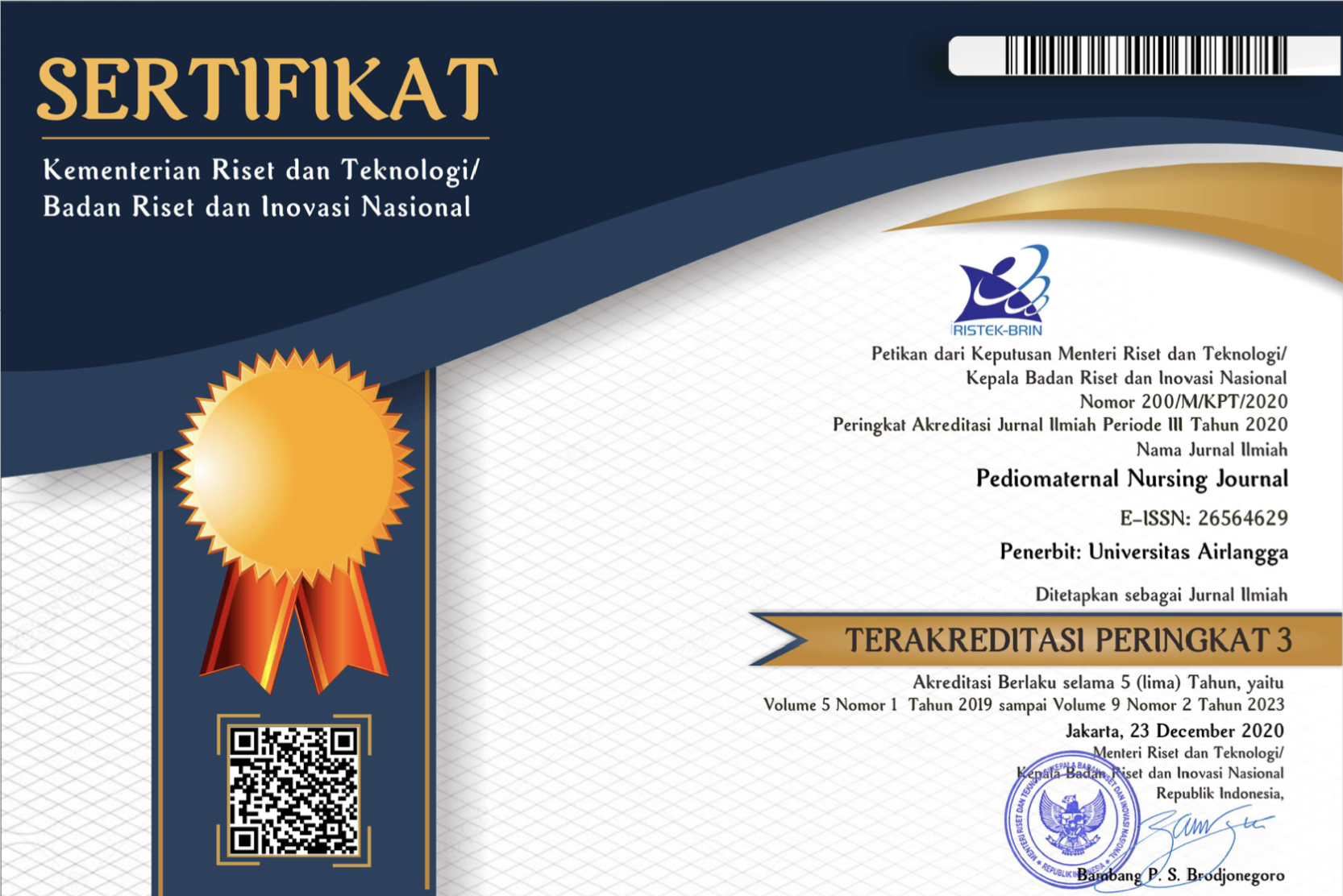Prevalence and Factors Affecting the Labor Experience: A Systematic Review
Downloads
Introduction: Labor experiences have potential short and long term physical and psychological effects on women's lives. Many factors influenced role in a mother's experience of childbirth, both positively and negatively. This study aimed to determine the prevalence and factors that influence the delivery experience.
Methods: This study searched for articles in the databases, namely Pub Med, Scopus, ProQuest, ScienceDirect, and Sage. The keyword used is labor experience. A total of 3654 articles were found, after selecting studies using PRISMA found 18 corresponding articles.
Results: In this study, 18 studies were included in this systematic review, eight studies examined the prevalence of labor experiences. The prevalence of labor experience was 6.8-44%. Factors related to childbirth experiences included: individuals, such as age, parity, fear, self-efficacy, participation, control, expectations, preparation, and interpersonal, such as husband support, caregiver support, unwanted medical problems, such as prolonged labor, stimulation, and induction, forceps delivery, emergency cesarean section, and use of analgesics in mothers, low APGAR scores and transfer to the NICU.
Conclusion: This review showed the various factors associated with the childbirth experience. This finding suggests conducting further research into the reason these factors influence the experience of labor.
Al Ahmar, E., & Tarraf, S. (2014). Assessment of the Socio-Demographic Factors Associated with the Satisfaction Related to the Childbirth Experience. Open Journal of Obstetrics and Gynecology, 04(10), 585–611. https://doi.org/10.4236/ojog.2014.410083
Azmoude, E., Farkhondeh, F., Ahour, M., & Kabirian, M. (2017). Knowledge, practice and self-efficacy in evidence-based practice among midwives in East Iran. Sultan Qaboos University Medical Journal, 17(1), e66–e73. https://doi.org/10.18295/squmj.2016.17.01.012
Baldino, V. M. C. L., Eckert, G. U., Rossatto, J., & Wagner, M. B. (2020). Red reflex test at the maternity hospital: results from a tertiary hospital and variables associated with inconclusive test results. Jornal de Pediatria, 96(6), 748–754. https://doi.org/10.1016/j.jped.2019.08.007
Bandura, A. (2010). Self Efficacy Mechanism in Psikological and Health Promoting Behavior.
Dahlberg, U., Persen, J., Skogås, A. K., Selboe, S. T., Torvik, H. M., & Aune, I. (2016). How can midwives promote a normal birth and a positive birth experience? The experience of first-time Norwegian mothers. Sexual and Reproductive Healthcare, 7, 2–7. https://doi.org/10.1016/j.srhc.2015.08.001
Desmawati, Kongsuwan, W., & Chatchawet, W. (2020). The effects of childbirth preparation nursing intervention integrating islamic praying program on duration of labor and neonatal outcomes in primiparous muslim women. Walailak Journal of Science and Technology, 17(10), 1048–1059. https://doi.org/10.48048/wjst.2020.5456
Elvander, C., Cnattingius, S., & Kjerulff, K. H. (2013). Birth experience in women with low, intermediate or high levels of fear: Findings from the first baby study. Birth, 40(4), 289–296. https://doi.org/10.1111/birt.12065
Hassanzadeh, R., Abbas-Alizadeh, F., Meedya, S., Mohammad-Alizadeh-Charandabi, S., & Mirghafourvand, M. (2020). Fear of childbirth, anxiety and depression in three groups of primiparous pregnant women not attending, irregularly attending and regularly attending childbirth preparation classes. BMC Women's Health, 20(1), 1–8. https://doi.org/10.1186/s12905-020-01048-9
Henriksen, L., Grimsrud, E., Schei, B., & Lukasse, M. (2017). Factors related to a negative birth experience – A mixed methods study. Midwifery, 51, 33–39. https://doi.org/10.1016/j.midw.2017.05.004
Henriksen, L., Nordström, M., Nordheim, I., Lundgren, I., & Blix, E. (2020). Norwegian women's motivations and preparations for freebirth”A qualitative study. Sexual and Reproductive Healthcare, 25(March), 100511. https://doi.org/10.1016/j.srhc.2020.100511
Hildingsson, I. (2017). Sense of coherence in pregnant and new mothers – A longitudinal study of a national cohort of Swedish speaking women. Sexual and Reproductive Healthcare, 11, 91–96. https://doi.org/10.1016/j.srhc.2016.10.001
Howarth, A. M., & Swain, N. R. (2019). Skills-based childbirth preparation increases childbirth self-efficacy for first time mothers. Midwifery, 70, 100–105. https://doi.org/10.1016/j.midw.2018.12.017
Karlström, A., Nystedt, A., & Hildingsson, I. (2015). The meaning of a very positive birth experience: Focus groups discussions with women. BMC Pregnancy and Childbirth, 15(1), 1–8. https://doi.org/10.1186/s12884-015-0683-0
Levett, K. M., Lord, S. J., Dahlen, H. G., Smith, C. A., Girosi, F., Downe, S., Finlayson, K. W., Fleet, J., Steen, M., Davey, M. A., Newnham, E., Werner, A., Arnott, L., Sutcliffe, K., Seidler, A. L., Hunter, K. E., & Askie, L. (2020). The AEDUCATE Collaboration. Comprehensive antenatal education birth preparation programmes to reduce the rates of caesarean section in nulliparous women. Protocol for an individual participant data prospective meta-analysis. BMJ Open, 10(9), e037175. https://doi.org/10.1136/bmjopen-2020-037175
Mukamurigo, J. U., Berg, M., Ntaganira, J., Nyirazinyoye, L., & Dencker, A. (2017). Associations between perceptions of care and women's childbirth experience: A population-based cross-sectional study in Rwanda. BMC Pregnancy and Childbirth, 17(1), 1–7. https://doi.org/10.1186/s12884-017-1363-z
Neerland, C. E., Avery, M. D., Looman, W. S., Saftner, M. A., Rockwood, T. H., & Gurvich, O. V. (2020). Development and Testing of the Preparation for Labor and Birth Instrument. JOGNN - Journal of Obstetric, Gynecologic, and Neonatal Nursing, 49(2), 200–211. https://doi.org/10.1016/j.jogn.2019.12.006
Puspasari, J., Nur Rachmawati, I., & Budiati, T. (2018). Family support and maternal self-efficacy of adolescent mothers. Enfermeria Clinica, 28, 227–231. https://doi.org/10.1016/S1130-8621(18)30073-1
Sbrilli, M. D., Duncan, L. G., & Laurent, H. K. (2020). Effects of prenatal mindfulness-based childbirth education on child-bearers' trajectories of distress: a randomized control trial. BMC Pregnancy and Childbirth, 20(1), 1–13. https://doi.org/10.1186/s12884-020-03318-8
Smarandache, A., Kim, T. H. M., Bohr, Y., & Tamim, H. (2016). Predictors of a negative labour and birth experience based on a national survey of Canadian women. BMC Pregnancy and Childbirth, 16(1), 1–9. https://doi.org/10.1186/s12884-016-0903-2
Ulfsdottir, H., Nissen, E., Ryding, E. L., Lund-Egloff, D., & Wiberg-Itzel, E. (2014). The association between labour variables and primiparous women's experience of childbirth; a prospective cohort study. BMC Pregnancy and Childbirth, 14(1), 1–7. https://doi.org/10.1186/1471-2393-14-208
Waldenström, U., Hildingsson, I., Rubertsson, C., & Rådestad, I. (2004). A negative birth experience: Prevalence and risk factors in a national sample. Birth, 31(1), 17–27. https://doi.org/10.1111/j.0730-7659.2004.0270.x
Copyright (c) 2021 Nur Hidayatin

This work is licensed under a Creative Commons Attribution 4.0 International License.
1. The journal allows the author to hold the copyright of the article without restrictions.
2. The journal allows the author(s) to retain publishing rights without restrictions.
3. The legal formal aspect of journal publication accessibility refers to Creative Commons Attribution (CC BY).





















